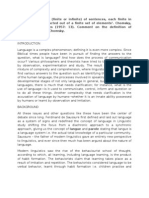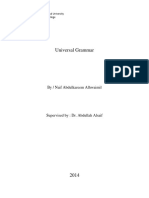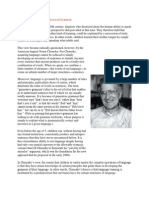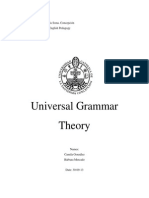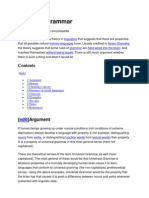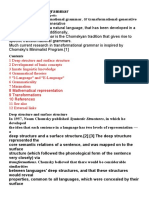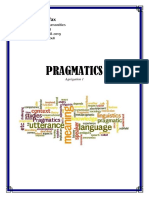Tool Module
Uploaded by
Meriem AdemTool Module
Uploaded by
Meriem AdemTool Module: Chomsky’s Universal Grammar
During the first half of the 20th century, linguists who theorized about the human ability to speak did so from the
behaviourist perspective that prevailed at that time. They therefore held that language learning, like any other
kind of learning, could be explained by a succession of trials, errors, and rewards for success. In other words,
children learned their mother tongue by simple imitation, listening to and repeating what adults said.
This view became radically questioned, however, by the American
linguist Noam Chomsky. For Chomsky, acquiring language cannot
be reduced to simply developing an inventory of responses to
stimuli, because every sentence that anyone produces can be a
totally new combination of words. When we speak, we combine a
finite number of elements—the words of our language—to create
an infinite number of larger structures—sentences.
Moreover, language is governed by a large number of rules and
principles, particularly those of syntax, which determine the order
of words in sentences. The term “generative grammar”refers to
the set of rules that enables us to understand sentences but of
which we are usually totally unaware. It is because of generative
grammar that everyone says “that’s how you say it” rather than
“how that’s you it say”, or that the words “Bob”and “him” cannot
mean the same person in the sentence “Bob loves him.” but can
do so in “Bob knows that his father loves him.” (Note in passing
that generative grammar has nothing to do with grammar
textbooks, whose purpose is simply to explain what is
grammatically correct and incorrect in a given language.)
Even before the age of 5, children can, without having had any
formal instruction, consistently produce and interpret sentences
that they have never encountered before. It is this extraordinary
ability to use language despite having had only very partial
exposure to the allowable syntactic variants that led Chomsky to
formulate his “poverty of the stimulus” argument, which was the
foundation for the new approach that he proposed in the early
1960s.
In Chomsky’s view, the reason that children so easily master the complex operations of language is that they
have innate knowledge of certain principles that guide them in developing the grammar of their language. In
other words, Chomsky’s theory is that language learning is facilitated by a predisposition that our brains have
for certain structures of language.
But what language? For Chomsky’s theory to hold true, all of the languages in the world must share certain
structural properties. And indeed, Chomsky and other generative linguists like him have shown that the 5000 to
6000 languages in the world, despite their very different grammars, do share a set of syntactic rules and
principles. These linguists believe that this “universal grammar” is innate and is embedded somewhere in the
neuronal circuitry of the human brain. And that would be why children can select, from all the sentences that
come to their minds, only those that conform to a “deep structure” encoded in the brain’s circuits.
Universal grammar
Universal grammar, then, consists of a set of unconscious constraints that let us decide whether a sentence is
correctly formed. This mental grammar is not necessarily the same for all languages. But according to
Chomskyian theorists, the process by which, in any given language, certain sentences are perceived as correct
while others are not, is universal and independent of meaning.
Thus, we immediately perceive that the sentence “Robert book reads the” is not correct English, even though
we have a pretty good idea of what it means. Conversely, we recognize that a sentence such as “Colorless
green ideas sleep furiously.” is grammatically correct English, even though it is nonsense.
A pair of dice offers a useful metaphor to explain what Chomsky means when he refers to universal grammar
as a “set of constraints”. Before we throw the pair of dice, we know that the result will be a number from 2 to 12,
but nobody would take a bet on its being 3.143. Similarly, a newborn baby has the potential to speak any of a
number of languages, depending on what country it is born in, but it will not just speak them any way it likes: it
You might also like
- Hourglass Workout Program by Luisagiuliet 276% (21)Hourglass Workout Program by Luisagiuliet 251 pages
- The Hold Me Tight Workbook - Dr. Sue Johnson100% (16)The Hold Me Tight Workbook - Dr. Sue Johnson187 pages
- Read People Like A Book by Patrick King-Edited62% (65)Read People Like A Book by Patrick King-Edited12 pages
- Livingood, Blake - Livingood Daily Your 21-Day Guide To Experience Real Health77% (13)Livingood, Blake - Livingood Daily Your 21-Day Guide To Experience Real Health260 pages
- COSMIC CONSCIOUSNESS OF HUMANITY - PROBLEMS OF NEW COSMOGONY (V.P.Kaznacheev,. Л. V. Trofimov.)94% (212)COSMIC CONSCIOUSNESS OF HUMANITY - PROBLEMS OF NEW COSMOGONY (V.P.Kaznacheev,. Л. V. Trofimov.)212 pages
- Donald Trump & Jeffrey Epstein Rape Lawsuit and Affidavits83% (1016)Donald Trump & Jeffrey Epstein Rape Lawsuit and Affidavits13 pages
- The 36 Questions That Lead To Love - The New York Times94% (34)The 36 Questions That Lead To Love - The New York Times3 pages
- The 36 Questions That Lead To Love - The New York Times95% (21)The 36 Questions That Lead To Love - The New York Times3 pages
- Jeffrey Epstein39s Little Black Book Unredacted PDF75% (12)Jeffrey Epstein39s Little Black Book Unredacted PDF95 pages
- The 4 Hour Workweek, Expanded and Updated by Timothy Ferriss - Excerpt23% (954)The 4 Hour Workweek, Expanded and Updated by Timothy Ferriss - Excerpt38 pages
- Chomsky's Generative Grammar: An Insight Into The Chomskyan Legacy To LinguisticsNo ratings yetChomsky's Generative Grammar: An Insight Into The Chomskyan Legacy To Linguistics10 pages
- Explain The Concept of Universal Grammar. How Is It Possible To Have Universal Grammar When Each Language Has Different Grammatical Rules?No ratings yetExplain The Concept of Universal Grammar. How Is It Possible To Have Universal Grammar When Each Language Has Different Grammatical Rules?5 pages
- Universal Grammar: Universal Grammar (UG) (Noun) : A Theory in Linguistics Usually Credited ToNo ratings yetUniversal Grammar: Universal Grammar (UG) (Noun) : A Theory in Linguistics Usually Credited To47 pages
- Outline of Materials For It Is Going To Be Presented As A Presentation TooNo ratings yetOutline of Materials For It Is Going To Be Presented As A Presentation Too7 pages
- On Universal Grammar and Language Acquisition: Homo Sapiens Is Able To Do ThisNo ratings yetOn Universal Grammar and Language Acquisition: Homo Sapiens Is Able To Do This7 pages
- Generativism: Chomsky's Linguistic ConcernsNo ratings yetGenerativism: Chomsky's Linguistic Concerns52 pages
- Noam Chomsky Theory of Universal GrammarNo ratings yetNoam Chomsky Theory of Universal Grammar11 pages
- Ibbotson y Tomasello - 2016 - Scientific-AmericanNo ratings yetIbbotson y Tomasello - 2016 - Scientific-American16 pages
- chomsky_language_acquisition_device_theoryNo ratings yetchomsky_language_acquisition_device_theory3 pages
- Universal Grammar: Rizal Technological University Maybunga, Pasig City College of EducationNo ratings yetUniversal Grammar: Rizal Technological University Maybunga, Pasig City College of Education4 pages
- Transformational Grammar: Transformations. Chomsky Believed That There Would Be ConsiderableNo ratings yetTransformational Grammar: Transformations. Chomsky Believed That There Would Be Considerable11 pages
- Universal Grammar: Rizal Technological University Maybunga, Pasig City College of EducationNo ratings yetUniversal Grammar: Rizal Technological University Maybunga, Pasig City College of Education4 pages
- The Physical Foundation of Language: Exploration of a HypothesisFrom EverandThe Physical Foundation of Language: Exploration of a HypothesisNo ratings yet
- Using Games in Education A Guide For Parents Teachers100% (1)Using Games in Education A Guide For Parents Teachers155 pages
- Active Learning Motivating Students To LearnNo ratings yetActive Learning Motivating Students To Learn30 pages
- EG - 04 - Subject Verb Agreement - Eng - Topic 1 To 5No ratings yetEG - 04 - Subject Verb Agreement - Eng - Topic 1 To 511 pages
- Syntax: The Sentence Patterns of LanguageNo ratings yetSyntax: The Sentence Patterns of Language7 pages
- Necessary, A Rule Not Allowed, A Rule: Must Mustn't Have To Can't Can Have ToNo ratings yetNecessary, A Rule Not Allowed, A Rule: Must Mustn't Have To Can't Can Have To3 pages
- 1 The Verb-Particle Combination in Present-Day EnglishNo ratings yet1 The Verb-Particle Combination in Present-Day English28 pages
- Future Perfect Tense & Future Perfect Continous Tense100% (1)Future Perfect Tense & Future Perfect Continous Tense6 pages
- Perform: CBSE, Direct and Indirect Speech For Class/Grade 6 - Exercise, Examples, Worksheet, PDF78% (9)Perform: CBSE, Direct and Indirect Speech For Class/Grade 6 - Exercise, Examples, Worksheet, PDF4 pages
- Nouns Singular and Plural Grammar Guides Picture Dictionaries - 38791No ratings yetNouns Singular and Plural Grammar Guides Picture Dictionaries - 387911 page
- Task 1 M5 LA1 Understanding The Nature of Explanation TextsNo ratings yetTask 1 M5 LA1 Understanding The Nature of Explanation Texts2 pages
- IE Express67 Listening12 All Completion Task TypesNo ratings yetIE Express67 Listening12 All Completion Task Types12 pages




























